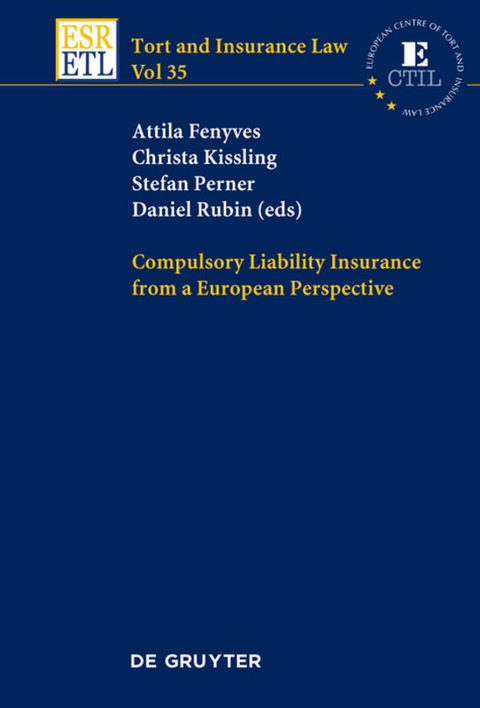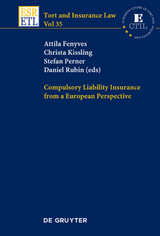Compulsory Liability Insurance from a European Perspective
Seiten
2016
De Gruyter (Verlag)
978-3-11-048469-4 (ISBN)
De Gruyter (Verlag)
978-3-11-048469-4 (ISBN)
Liability law is rapidly changing in quite a number of countries. This is due to various factors, which are interrelated to a large extent: changing case law and legislation as well as increased and still increasing technical and medical knowledge. As a result, various occupational diseases can, for example, be attributed to working conditions or personal injury to specific products. From the very moment that causation can be proven, the question arises of whether or not liability can be established‑ with far-reaching economic consequences for all parties involved. The rise of phenomena such as mass torts, multiple causation, joint and several liability or various heads of damages (like ecological damage and several diseases and affections) rapidly increases the interest in tort law. In the context of the interrelation between liability and insurance, attention must be paid to the question of whether certain liabilities are still coverable or not, and, if they are, to what amounts. (The question of jurisdictions is of growing importance as is the question of whether a specific liability can be covered by insurance. In this context, one should bear in mind that the affordability of tort law also requires safe and sound insurers. The recent past has shown that there is a limit to their financial stability.)
Statutory obligations to take out liability insurance are, in practice, the most important means to ensure compensability of damage arising from dangerous activities. However, in contrast to the significant practical impact, academic research on the topic has not been extensive so far. This study, therefore, undertakes a comprehensive survey of compulsory liability insurance from nine national perspectives (Austria, Belgium, the Czech Republic, Finland, Germany, Hungary, Italy, Switzerland, and the United Kingdom) and takes constitutional and European law (four freedoms, European Convention on Human Rights) as well as the Principles of European Insurance Contract Law (PEICL) into account. It also contains an extensive economic analysis of compulsory liability insurance and discusses aspects of insurability. A Comparative Report, Conclusions and an Annex containing a compilation of rules on compulsory liability insurance in the nine national legal systems complete the study. It considers in particular: the aims of provisions stating an obligation to take out liability insurance the mandatory content of insurance cover the protection mechanisms linked to compulsory liability insurance the control mechanisms and the sanctions imposed structural deficiencies of existing compulsory liability insurance systems
Statutory obligations to take out liability insurance are, in practice, the most important means to ensure compensability of damage arising from dangerous activities. However, in contrast to the significant practical impact, academic research on the topic has not been extensive so far. This study, therefore, undertakes a comprehensive survey of compulsory liability insurance from nine national perspectives (Austria, Belgium, the Czech Republic, Finland, Germany, Hungary, Italy, Switzerland, and the United Kingdom) and takes constitutional and European law (four freedoms, European Convention on Human Rights) as well as the Principles of European Insurance Contract Law (PEICL) into account. It also contains an extensive economic analysis of compulsory liability insurance and discusses aspects of insurability. A Comparative Report, Conclusions and an Annex containing a compilation of rules on compulsory liability insurance in the nine national legal systems complete the study. It considers in particular: the aims of provisions stating an obligation to take out liability insurance the mandatory content of insurance cover the protection mechanisms linked to compulsory liability insurance the control mechanisms and the sanctions imposed structural deficiencies of existing compulsory liability insurance systems
Attila Fenyves, Universität Wien; Christa Kissling, ETL Wien; Stefan Perner, Universität Linz; Daniel Rubin, Universität Wien
Attila Fenyves, Universität Wien; Christa Kissling, Vienna; Stefan Perner, Universität Linz; Daniel Rubin, Universität Wien
| Erscheinungsdatum | 26.09.2016 |
|---|---|
| Reihe/Serie | Tort and Insurance Law ; 35 |
| Verlagsort | Berlin/Boston |
| Sprache | englisch |
| Maße | 155 x 230 mm |
| Gewicht | 967 g |
| Themenwelt | Recht / Steuern ► EU / Internationales Recht |
| Recht / Steuern ► Privatrecht / Bürgerliches Recht ► Besonderes Schuldrecht | |
| Schlagworte | Comparative • comparative law • Embodying • Europe • Haftung • international • Internationales Recht, Ausländisches Recht • Larios • Law • liability insurance • Liability insurance, Europe • Liability (Law) • Liability (Law), Europe • Schadenersatzrecht • Tort law • torts • Torts, Europe • vedas • Versicherungsrecht |
| ISBN-10 | 3-11-048469-2 / 3110484692 |
| ISBN-13 | 978-3-11-048469-4 / 9783110484694 |
| Zustand | Neuware |
| Haben Sie eine Frage zum Produkt? |
Mehr entdecken
aus dem Bereich
aus dem Bereich
steueroptimiert übertragen und den Schenker absichern
Buch | Softcover (2023)
C.H.Beck (Verlag)
CHF 20,85
Vertragliche Schuldverhältnisse
Buch | Softcover (2022)
C.F. Müller (Verlag)
CHF 36,40
Bürgerliches Gesetzbuch, EuErbVO, ZPO, FamFG, BeurkG, HöfeO, ErbStG, …
Buch | Softcover (2023)
dtv Verlagsgesellschaft
CHF 36,25




